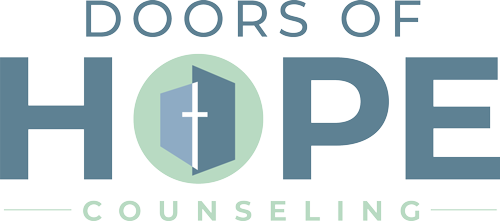Let’s Play: What Is Play Therapy and Is It Right For My Child?
By: Jenna Barton, LPC
WHAT IS PLAY THERAPY?!
The Association of Play Therapy defines play therapy as, “the systematic use of a theoretical model to establish an interpersonal process wherein trained play therapists use the therapeutic powers of play to help clients prevent or resolve psychosocial difficulties and achieve optimal growth and development”. The British Association of Play Therapists (BAPT) defines it in a way that Doors of Hope therapist, Jenna Barton, likes to use when meeting with parents; “the dynamic process between child and play therapist in which the child explores at his or her own pace and with his/her own agenda the issues, past and current, conscious and unconscious, that are affecting the child’s life in the present. The child’s inner resources are enabled by the therapeutic alliance to bring about growth and change. Play therapy is child-centered, in which play is the primary medium and speech is the secondary medium”.
There are many different treatment modalities a therapist can use to apply the therapeutic benefits of play, and these will be discussed as you continue to read. And it is different than regular play between peers or parents and child(ren). The therapist helps children address and resolve their own problems. ‘Play’ is the main way children learn about themselves, relationships, and how they fit into their world. Play therapy helps build on this concept. Play provides a psychologically safe distance from issues/problems to allow expression of thoughts and feelings appropriate to their development.
WHY PLAY?!
Putting it plainly and simply……children learn through play! One of play therapy’s celebrities, Gary Landreth, believes, “Toys are like the child’s words and play is the child’s language”. Developmentally speaking, children don’t always have the verbal language to express their thoughts and feelings—play(therapy) gives them that voice/ability to communicate. To quote Plato, “You can discover more about a person in an hour of play than in a year of conversation”.
The positive therapeutic play relationship between therapist and child developed in session can provide a corrective emotional experience necessary for healing. It helps to promote and provide insight and resolution to children’s inner conflicts or dysfunctional thinking.
SPEAKING OF CELELBRITIES….!
Virginia Axline is considered the mother of play therapy; she applied Rogerian concepts to play therapy to pioneer Child Centered Play Therapy (CCPT), also known as, Non-Directive Play Therapy. Gary Landreth expanded upon CCPT and his work has been instrumental in the exponential growth of the field. And Bernard and Louise Guerney developed Filial Therapy, a form of therapy that engages parents as partners in the therapeutic process and empowers them to be the primary change agents for their own children.
OTHER TREATMENT MODALITIES/METHODS
As introduced above, in child-centered play therapy, the therapist believes that children have the innate ability to be constructively self-directing and self-healing if provided the essential conditions of unconditional positive regard, empathic understanding, and congruence. In Directive play therapy, the therapist assumes responsibility for initiating and structuring the client’s play activities to promote healing. Dyadic play therapy is a short-term therapy approach that uses play interactions to foster relationship skills in a pair of children, like in siblings for example. Gestalt play therapy uses play activities to promote the development of client self-awareness and personal responsibility with a focus on the present. Sandplay therapy uses play with sand and miniature objects/figures/toys that requires extensive training in Jungian interpretation and symbolism leading to specialized certification. Theraplay is a short-term, attachment-based intervention utilizing non-symbolic, interaction play to re-create experiences of secure attachment formation between parent and child.
Jenna Barton utilizes a lot of Child-Centered Play Therapy in her work with young children. In CCPT, children are encouraged to be themselves. The unconditional positive regard and empathy from the therapist can facilitate and unleash a child’s potential to explore and express emotions in a safe environment and enhances growth. With CCPT, there’s an overall assumption that children have a push/motivation to/for self-realization like in person-centered psychotherapy (Rogerian) for adults. Axline (1969) developed eight principles in the CCPT process that parents and clients can expect to experience/observe. The therapist will:
- Develop a warm, friendly rapport with the child
- Accept the child just as he/she is, no matter the day/session
- Allow the child to express him/herself freely and completely by establishing a sense of permissiveness
- Recognize the feelings the child expresses and reflect those back in a way that allows the client to gain insight into his/her own behavior
- Maintain and communicate a deep respect for the child’s ability to solve problems, make choices, and institute change
- Allow the child to lead the way in ALL aspects of therapy, refraining from directing the child’s play in ANY way
- Allow the therapy process to develop at its natural pace without being hurried in any way
- Establish limitations only when necessary to anchor the therapy to reality and with therapeutic benefit that provides insight into the child’s awareness of his/her responsibility in the relationship
You can expect a child-centered play therapist to track behavior, reflect content and emotion/feeling, return responsibility back to the client, facilitate creativity and esteem building, facilitate relationship, reflect deeper meaning in the child’s play, and utilize limit-setting when needed/appropriate. We use the simple acronym, ACT, for therapeutic limit setting and choice giving. All feelings, desires, and wishes of the child are accepted, but not all behaviors are accepted. This acronym can also be used at home between parent and child. Specific steps in limit setting are:
-
- (A)– ACKNOWLEDGE the child’s feelings, wishes, and wants
- (C)– COMMUNICATE the limit
- (T)– TARGET acceptable alternative(s).
WHAT MAKES DIRECTIVE PLAY THERAPY DIFFERENT?!
Well, thanks for asking! There are many differences between the directive and non directive modalities. Age/developmental level plays a roll also in determining which modality is a better fit for a client. In directive play therapy, the therapist sets out with specific interventions and goals in mind for sessions. He/she knows the direction of the discussion and session. Toys and activities are often chosen ahead of time by the therapist too, whereas in CCPT, the child exclusively makes the toy and activity choices. In directive play therapy, therapists intentionally choose play situations and activities in an attempt to lead the child to discuss the problems at hand. Purposeful activities, such as games or art activities, are structured by the therapist to elicit imaginative responses from the client. The therapist assumes the responsibility for the guidance and interpretation of the play interactions in session.
Jenna isn’t the only therapist at Doors of Hope who uses play therapy in her practice working with children!! If you’re still wondering “what is play therapy and is it right for my child?” or are interested in scheduling an appointment, don’t hesitate to reach out and see if one of our awesome therapists is a good fit for you and your kiddo! And feel free to check out the links below to get more answers to the questions “what is play therapy and is it right for my child?” And to see play therapy in action!! LET’S PLAY!
A Look into Directive Play Therapy
Landreth doing Child-Centered Play Therapy/Nondirective PT

